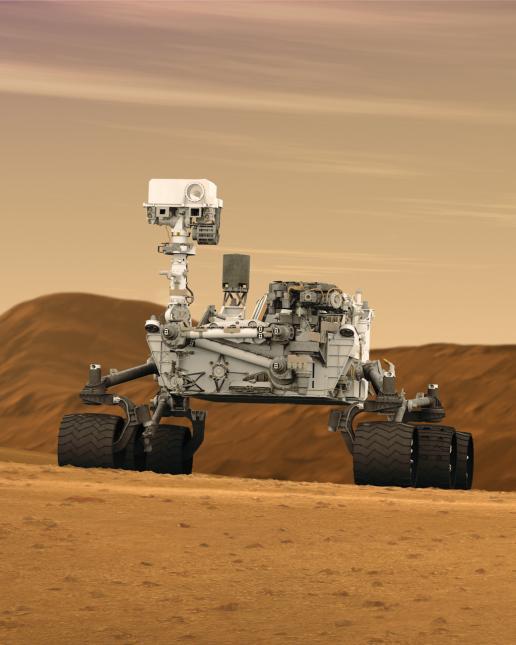NASA scientist James Rice has had the rare privilege of naming Martian landmarks, and he didn’t forget his roots on Earth when he did – one is named after his hometown of Tuscaloosa. He grew up and studied in Tuscaloosa and still finds time to visit, even though his work is 250 million miles away.
He said he hopes to one day name a rock or other landmark after his favorite football team, who he saw beat Ole Miss 33-14 this weekend.
“I wanted to name something Alabama or Crimson Tide, [but] I can’t promise it’s going to happen,” Rice said. “If you [name something] Alabama, you’d like to do University of Alabama, because you don’t want Auburn to have any credit or anything.”
Rice and Ryan Ewing, an assistant professor in the Department of Geological Sciences, represent a crimson connection to the red planet – a small part of a large team trying to uncover Mars’ secrets.
Rice is an astrogeologist studying rocks and the martian landscape for NASA. He graduated from the University in 1984 with a degree in geology, received a master’s degree from Northeast Louisiana University and a Ph.D. from Arizona State.
His love for Alabama, though, does not get lost as he explains some of the specifics of his geology work. Rice recalled sitting in Bryant-Denny Stadium in disgust when Cam Newton – “Scam,” he calls him – beat Alabama in the 2010 Iron Bowl. He includes scores of Alabama games in his emails to his NASA colleagues.
But he’s always had a certain fascination with Mars. It began in elementary school and continued when he was a student at Tuscaloosa High School.
“I think Mars is the most interesting planet in the solar system,” he said. “Maybe even more than Earth sometimes.”
The Mars Odyssey orbiter, which arrived at Mars in 2001 and is still in orbit today, was one of the first projects he worked on, and he was involved in the landing site selection for Curiosity, the rover which landed in early August 2012.
“They’ve got a lot to live up to,” he said of the Curiosity team. “Spirit and Opportunity re-wrote the science book of Mars.”
He holds Spirit and Opportunity, two rovers that landed on opposite sides of Mars in January 2004, close to his heart. While Curiosity has dominated the science headlines since its landing, he has worked more closely with the twin rovers and is still collecting and analyzing data from the Opportunity as a member of the science team,
The goal for the two rovers was just three months and 1,800 feet of driving distance. Spirit “died” two years ago after six years and 4.8 miles of exploration, while Opportunity is still alive and well, eight and a half years and more than 21 miles later.
Naming landmarks is a small perk his job entails. The crater Tuscaloosa dots the surface of Mars along with Northport crater and both names are a direct result of Rice’s work. And in the Victoria crater there is a rock named after Eugene Smith, the 19th century UA geology professor after whom Smith Hall is named.
Ewing, meanwhile, is collaborating with Gary Kocurek, a participating scientist on the Curiosity mission. Ewing and Kocurek are studying wind-blown sediments and rocks created by Martian winds.
The first challenge is differentiating the wind-blow sediments from sediments created by water. From there, the rocks can offer numerous clues to Mars’ history.
“Within that, we can say something about the wind conditions at that time,” Ewing said. “Are they different from today? How dynamic has Mars been through time? Is it possible that for four billion years Mars has been in the same general state it is in now? Or have things changed dramatically? That’s one of the questions we can pull out by looking at these rocks.”
Ewing has been fascinated by Mars ever since his undergraduate years at Colorado College.
“I kind of got obsessed,” he said.
He did an internship with NASA’s Lunar and Planetary Space Institute in Houston and went on to graduate school at the University of Texas.
Now in his second year as a faculty member at Alabama, Ewing is attempting to share his love for Mars and astrogeology with his students.
“He tried to get people interested in being geologists and how there’s going to be a new field of geologist astronauts,” said Noah Chisum, a UA junior who took Ewing’s Geology 101 class in the fall 2011, which was Ewing’s first semester on campus and a year before Curiosity’s landing. “He was excited about [Curiosity] and about what it was going to teach us about the solar system.”
Rice and Ewing met briefly in the spring and while their paths don’t cross often, they both connect Tuscaloosa to the solar system’s the fourth planet.
“It’s like a football team. Everybody’s got a role to play,” Rice said. “They’ve got to know what their job is. And when you do it and do it right, you win championships or survive on Mars for eight and a half years.”









